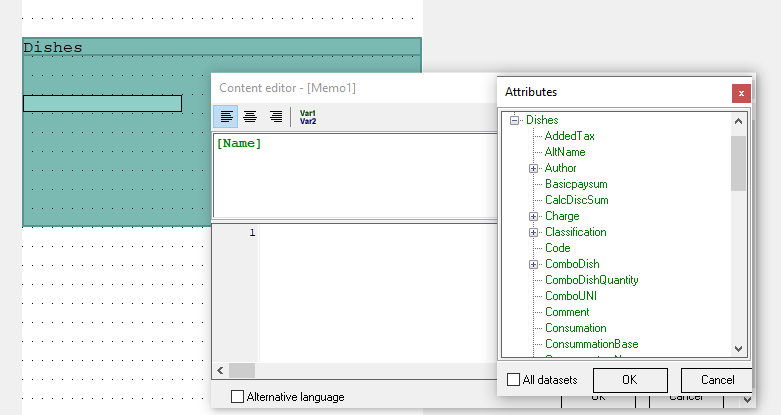...
Category
Any field of the data source can act as a category. The category is processed as follows: first, unique values are determined for the specified field, then a band is printed for each received value. Each time a band is printed, a filter of the type Category = Value is applied to the data source. For example, if you specify Currency Group as the category, then the Payment data source will be printed as follows:Currency
Order
Guests
Sum
Nat. Sum
Credit cards
Master card
1/4
5
100
100
Cash
Rubles
1/2
2
300
300
Euro
1/3
3
20
700
Rubles
1/5
2
500
500
Rubles
1/2
2
200
200
- Calculated Fields
Using this property, you can add calculated fields to the band dataset. You need to add calculated fields in order to group or sort by fields that are not present in the dataset but can be calculated based on its fields. Each calculated field is described by the following properties:
...
Header
A band header. Is printed first. It is characterized by the following properties:Colored
Печать содержимого колонтитула с выделением цветом. Работает, если принтер поддерживает инверсионную печать
Double Height
Двойная высота печати содержимого колонтитула
Double Width
Двойная ширина печати содержимого колонтитула
Show Empty Lines
Флаг определяет, печатать или нет пустые строки
Size
Высота колонтитула в строчках. Если 0, секция не печатается
...
Printing the header and footer contents with color highlighting. Works if the printer supports inversion printing
...
Double Height
Double
...
print height of header and footer content
Double Width
Double
...
print width of the header and footer content
...
Show Empty Lines
The flag determines whether to print
...
empty lines or not
...
Size
Header/footer height in lines. If 0, no section is printed
- Body
...
- A band body, displayed after printing the Header. The content of the band body is printed as many times as
...
- how many records
...
- the
...
- dataset contains. Band body properties are the same as header properties.
- Footer
...
- A band footer, displayed after the Header and Body of the band. The properties of the footer are the same as those of the header.
- Behavior
...
- — Show Empty
A flag indicating whether to display a band if there are no records in the data source
...
- linked with the band. By default, such bands are not displayed, even if they have a Header or Footer set.
- Before Start
A script that is executed before starting band processing. - After Finish
A script that is executed after the end of band processing. - Script
A script that is executed for each line of the data source, just before printing it. - XML Section
Used to export a printed document to XML. When exporting, the lines generated by this band will go to the section with the specified name. By default, the section name is the same as the data source name.
Memo
With In the help of a memo, individual separate fields of the data source or any text are can be displayed. Data source field names (variables) are enclosed in square brackets.
After the dataset is tied to the band, a memo can be placed inside this band. Variables from the dataset are inserted inside these memo, so the required dataset will be printed in the report.
image2021-5-8_10-56-19.png
It is important to understand that variables from a dataset can only be used within your its own band.
Memo properties
- Alignment
Specifies whether the text is aligned left,
...
- right, or
...
- centered.
- Content
Contains the text to be printed. To print fields from a data source, the field names must be enclosed in square brackets: [FieldName]. To print a field from another data source that is not
...
- linked to the band in which the memo is
...
- placed, you need to use the [DataSourceName.FieldName] construction. To print escape sequences, you need to use the <EscapeCommand> construct. The list of escape commands will be given below. The number of fields that can be displayed using one memo is not limited.
- Format
Specifies the variable format
...
- (number, date, time, other).
- Hide zeros
- Alternative language
- Word wrap
Enable auto-wrap. - XML Attributes
XML class
XML tag
Filter
...
Setting Example
Let's assume that you need to set up filtering of the Dish in the bill by category. It should look something like this:
| Code Block |
|---|
[Classification] |
...
[Category1] |
...
Dish1 Dish2 Dish3 Total for category: [priceamount] [Категория2] Dish4 Dish5 Dish6 Total for category: [priceamount] Total for classification |
Solution:
- Add a calculated field with the required classification to the dish
...
- band (f.ex., the Category field)
- Set
...
- Category = Category for the band
- Group
...
- the band by the Category field
- Add another
...
- band of dishes to the
...
- band
- Add the same calculated field to the nested band and set the same grouping
- The field for displaying the dish name must be added to the nested band, the field for the category name — to the external one.
